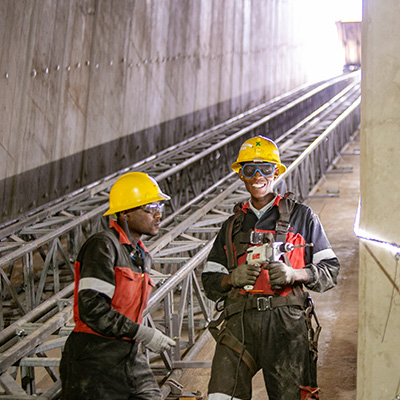Currently viewing: News Press Releases
Press Releases
-
DUAL-PURPOSE VENT SHAFT AT PLATREEF WILL ALSO HOIST ORE
Tuesday, 12 December 2023
In a project innovation that will allow early hoisting of ore at Ivanhoe Mines’ Platreef project, Murray & Roberts Cementation will be repurposing its 3 Shaft – a ventilation shaft – to serve a dual function.
“This is a unique project in many respects, as the shaft will be hoisting ore at that same time as allowing upcast air to reach surface,” explains Graham Chamberlain, New Business Director at Murray & Roberts Cementation. “We were able to bring our well experienced experts into the planning process to develop a safe and effective solution.”
The project has followed the sinking of the vent shaft by Murray & Roberts Cementation, which had required very accurate drilling, using raiseboring equipment guided by directional drilling technology. The 5,1 metre diameter shaft meets horizontal development at a depth of 950 metres below surface.
“During this process, Ivanhoe looked at bringing forward some of their ore generation activities, and this required adding hoisting capacity,” he explains. “The timeline for their main shaft meant that it would not be able to contribute to this capacity, so a team was established to consider how to retrofit the vent shaft into an early hoisting shaft.”
As an integral part of that multidisciplinary team, Murray & Roberts Cementation conducted a feasibility study on the options, allowing for the selection of the most suitable methodology. The company also carried out the necessary designs, including winders and headgear as well as hoisting and tipping arrangements. In September 2023, the project was awarded to Murray & Roberts Cementation to implement, and is scheduled to take about two years.
“This project stands out in terms of innovation, adaptability, teamwork and design,” he says. “With our many decades in the sector, we were able to draw on hundreds of years of experience in mining – and leverage this in our design team.”
Among the range of technical challenges is the need to work within the vent shaft while it is performing its function of channelling an upcast current of air to surface. Any blockage of the air current in the shaft would affect the development operation of the mine, so this is critical to avoid.
“There needs to be periods during which we can reduce the ventilation, but we will have to ensure that air flow is always adequate,” he says. Another vent shaft is planned to add ventilation capacity for the future.
Chamberlain points out that it will be necessary to deal with the slight deviations in the shaft; while accurately drilled, vent shafts are not designed to the same tolerances as hoist shafts. An important aspect of the design was the steelwork required to accommodate those deviations.
“The work will be conducted by a relatively small team of our highly skilled people,” he says. “This will include the installation of a compact headgear using refurbished winders from our strategic stockholding.”
The infrastructure will employ technology that will allow man-less operation to enhance safety, using automated processes in loading and measuring functions, for instance. The project will require specialised subcontractors on much of the equipment employed, but the more day-to-day consumables are procured locally to support local businesses.
“In the absence of a supplier, we would then develop their capability through our procurement system and enterprise development commitment,” he says. “In this way, we foster small businesses and help to nurture them until they are self-sustaining.”




